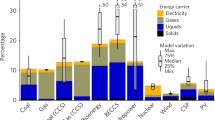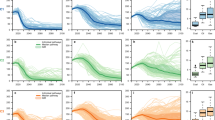Abstract
Climate change introduces an uncertain risk to power plant operations as ambient conditions potentially constrain generation through thermodynamic limitations. Previous studies aiming to quantify this risk have suggested a wide range of results, from minimal to disastrous capacity loss. In this analysis, we used a power plant modeling tool to study how a variety of power plant configurations respond to varying meteorological conditions. We developed tools that enable the analysis of the climate impacts on power plant operations for a spectrum of geographic situations and technological configurations. We also used these tools to conduct a case study for US coal and natural gas power plants in 2050, under climate change scenario representative concentration pathway 4.5. Our study indicates that rising air temperatures are unlikely to seriously threaten capacity and efficiency at power plants at most locations, provided that wet recirculating and dry cooling systems are designed adequately. Our results allow for simpler modeling of power plant capacity deratings given ambient conditions, highlight potential regions of risk, and underscore the importance of incorporating climate factors into the electric power system’s design and planning.






Similar content being viewed by others
References
ASHRAE (2008) Chapter 39: cooling towers. In: ASHRAE handbook
Bartos MD, Chester MV (2015) Impacts of climate change on electric power supply in the Western United States. Nat Clim Chang 5:748–752. https://doi.org/10.1038/nclimate2648
Bennett A, Hamman J, Nijssen B, et al (2019) MetSim v2.0.0. doi: https://doi.org/10.5281/zenodo.3247806
Carnegie Mellon University (2016) Integrated Environmental Control Model (IECM) Version 9.5
Davies EGR, Kyle P, Edmonds JA (2013) Adv Water Resour 52:296–313. https://doi.org/10.1016/j.advwatres.2012.11.020
Electric Power Research Institute (EPRI) (2007) Issues analysis of retrofitting once- through cooled plants with closed-cycle cooling. EPRI, Palo Alto
Electric Power Research Institute (EPRI) (2012) Program on technology innovation: tradeoffs between once-through cooling and closed-cycle cooling for nuclear power plants. EPRI, Palo Alto
Fonseca FR (2020) Effects of climate change on the power system: a case study of the southeast U.S.
Fonseca FR, Jaramillo P, Bergés M, Severnini E (2019) Seasonal effects of climate change on intra-day electricity demand patterns. Clim Chang 154:435–451. https://doi.org/10.1007/s10584-019-02413-w
Harto CB, Yan YE, Demissie YK et al (2012) Analysis of drought impacts on electricity production in the Western and Texas interconnections of the United States. Argonne National Laboratory
Henry CL, Pratson LF (2016) Effects of environmental temperature change on the efficiency of coal- and natural gas-fired power plants. Environ Sci Technol 50:9764–9772. https://doi.org/10.1021/acs.est.6b01503
Kenny J, Barber N, Hutson S et al (2009) Estimated use of water in the United States in 2005. US Geological Survey
Koch H, Vögele S (2009) Ecol Econ 68:2031–2039. https://doi.org/10.1016/j.ecolecon.2009.02.015
Lawrence Berkeley National Laboratory (2012) Estimating risk to California energy infrastructure from projected climate change. California Energy Commission
Liu L, Hejazi M, Li H et al (2017) Vulnerability of US thermoelectric power generation to climate change when incorporating state-level environmental regulations. Nat Energy 2:17109. https://doi.org/10.1038/nenergy.2017.109
Macknick J, Newmark R, Heath G, Hallett KC (2011) A review of operational water consumption and withdrawal factors for electricity generating technologies. Golden, NREL
McCall J, Macknick J, Hillman D (2016) Water-related power plant curtailments: an overview of incidents and contributing factors. Golden, NREL
Meng M, Sanders KT (2019) A data-driven approach to investigate the impact of air temperature on the efficiencies of coal and natural gas generators. Appl Energy 253:113486. https://doi.org/10.1016/j.apenergy.2019.113486
Miara A, Macknick JE, Vörösmarty CJ et al (2017) Climate and water resource change impacts and adaptation potential for US power supply. Nat Clim Chang 7:793–798. https://doi.org/10.1038/nclimate3417
Mohseni O, Stefan HG, Erickson TR (1998) A nonlinear regression model for weekly stream temperatures. Water Resour Res 34(10):2685–2692
Roy S, Chen L (2011) Water use for electricity generation and other sectors: recent changes (1985–2005) and future projections (2005–2030). EPRI, Palo Alto
Scanlon BR, Reedy RC, Duncan I et al (2013) Controls on water use for thermoelectric generation: case study Texas, U.S. Environ Sci Technol 47:11326–11334. https://doi.org/10.1021/es4029183
Sovacool BK, Sovacool KE (2009) Preventing national electricity-water crisis areas in the United States. Columbia Journal of Environmental Law 34:1–61
U.S. Energy Information Administration (EIA) (2018) EIA Form:860
US EPA (2015) Cooling water intakes — final 2014 rule for existing electric generating plants and factories
van Vliet MTH, Yearsley JR, Ludwig F et al (2012) Vulnerability of US and European electricity supply to climate change. Nat Clim Chang 2:676–681. https://doi.org/10.1038/nclimate1546
van Vliet MTH, Wiberg D, Leduc S, Riahi K (2016) Power-generation system vulnerability and adaptation to changes in climate and water resources. Nat Clim Chang 6:375–380. https://doi.org/10.1038/nclimate2903
van Vuuren DP, Edmonds J, Kainuma M et al (2011) The representative concentration pathways: an overview. Clim Chang 109:5–31. https://doi.org/10.1007/s10584-011-0148-z
Ward DM (2013) The effect of weather on grid systems and the reliability of electricity supply. Clim Chang 121:103–113. https://doi.org/10.1007/s10584-013-0916-z
Zamuda C, Mignone B, Bilello D, et al (2013) U.S. energy sector vulnerabilities to climate change and extreme weather. U.S. Department of Energy
Zhai H, Rubin ES (2010) Energy Policy 38:5653–5660. https://doi.org/10.1016/j.enpol.2010.05.013
Acknowledgments
Dr. Michael Craig generously helped gather empirical data to validate the regressions, and Linh Pham helped with data processing.
Funding
This project was supported by the National Science Foundation via Grant Number EFRI-1441131 and the National Oceanic and Atmospheric Administration via Award Number A14OAR4310249.
Author information
Authors and Affiliations
Corresponding author
Ethics declarations
Disclaimer
The results and conclusions of this paper are the sole responsibility of the authors and do not represent the views of the funding sources.
Additional information
Publisher’s note
Springer Nature remains neutral with regard to jurisdictional claims in published maps and institutional affiliations.
Electronic supplementary material
ESM 1
(DOCX 6460 kb)
Rights and permissions
About this article
Cite this article
Loew, A., Jaramillo, P., Zhai, H. et al. Fossil fuel–fired power plant operations under a changing climate. Climatic Change 163, 619–632 (2020). https://doi.org/10.1007/s10584-020-02834-y
Received:
Accepted:
Published:
Issue Date:
DOI: https://doi.org/10.1007/s10584-020-02834-y




